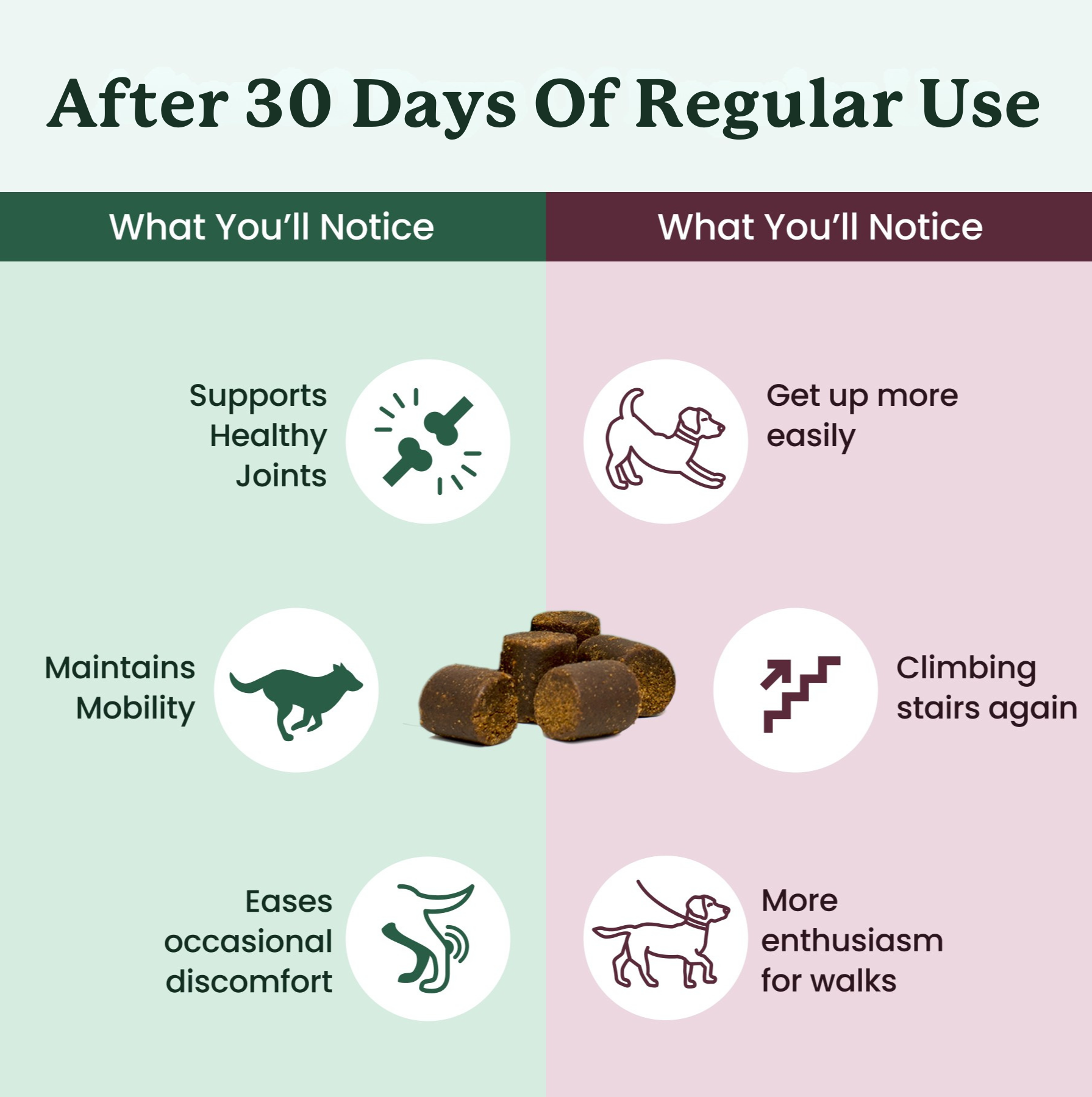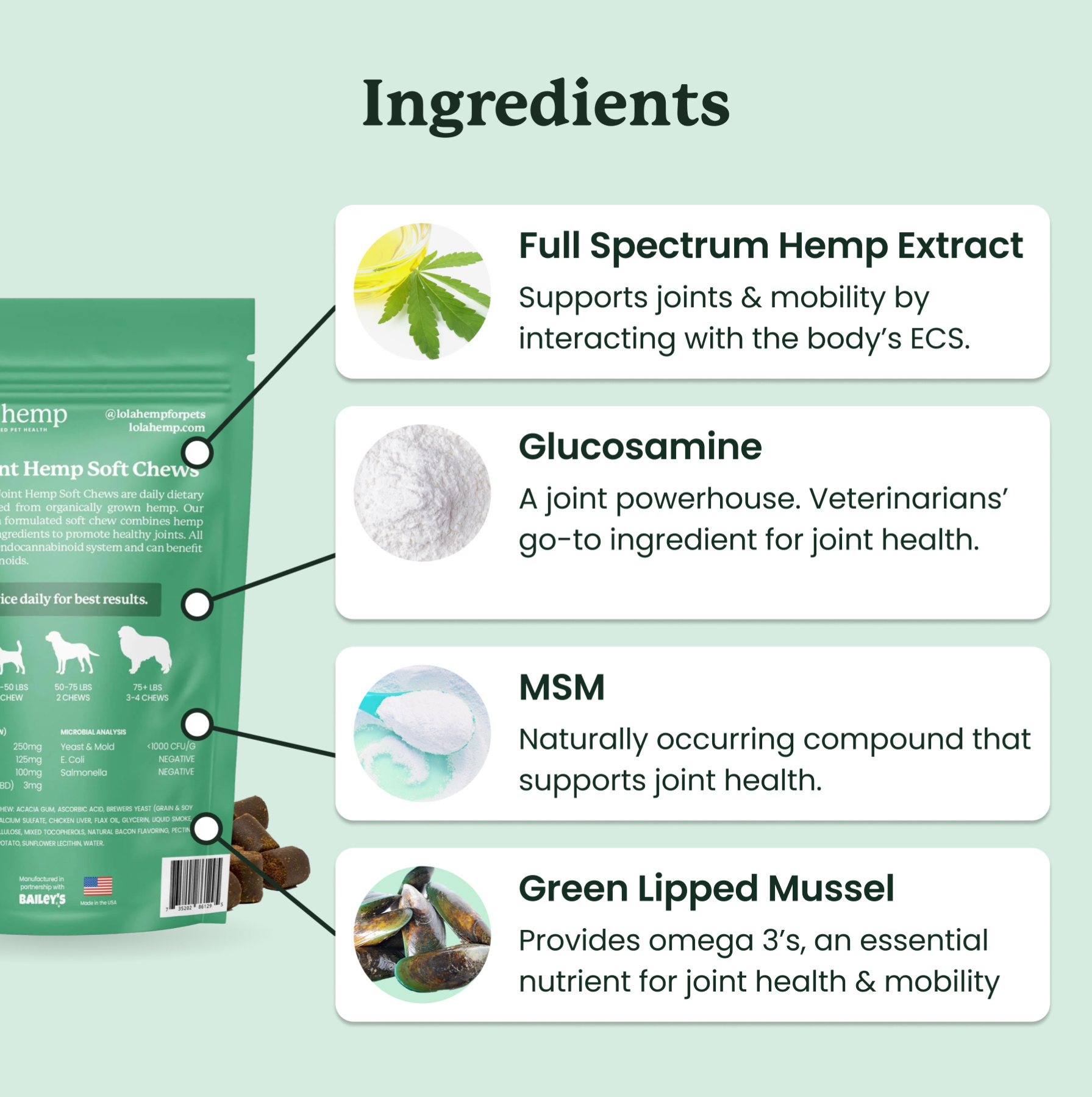Just like humans, dogs can experience muscle strains from overexertion, awkward movements, or even simple day-to-day activities. As you know from experience, a strained muscle can easily develop into a painful, ongoing issue if it goes untreated, leading to joint issues down the line.
Dogs are no different, and it's our job as pet owners to monitor their behavior to ensure their small pulls and strains don't evolve into something worse.
If your dog suddenly starts limping, hesitates to jump on the couch, or seems stiff after playtime, a muscle strain could be the culprit. Fortunately, there are a number of things we as dog owners can do to help our dogs heal and keep them mobile and happy for years to come.
We just have to be vigilant and know what to do when issues arise. So, let's take a look at muscle strains in dogs & how to help when they occur.
- What Is a Muscle Strain in Dogs?
- Common Causes of Muscle Strains
- Signs Your Dog May Have a Muscle Strain
- How Vets Diagnose Muscle Strains
- At-Home Care for Mild Muscle Strains
- When to Call the Vet
- Preventing Muscle Strains in Dogs
- Supporting Long-Term Mobility
- 1. How can I tell if my dog has a muscle strain?
- 2. How long does it take for a dog’s muscle strain to heal?
- 3. Should I walk my dog if they have a strained muscle?
- 4. Can I use heat or ice on my dog’s sore muscles?
- 5. What supplements help dogs recover from muscle strains?
- 6. When should I take my dog to the vet for a limp?
- 7. How can I prevent muscle strains in my dog?
What Is a Muscle Strain in Dogs?
A muscle strain happens when muscle fibers stretch or tear beyond their normal threshold. In dogs, tears usually occur during activities like running, jumping, chasing, or rough play. It's an easy thing to understand because we experience them in the same way.
We expect dogs to be nimble and resilient, though, so sometimes it's hard for us to know where our dogs' limits are. Younger dogs are typically more resilient, but they're also prone to extreme bursts of activity. Older dogs or those with underlying joint issues may also be more prone to strains.
Muscle strains differ from sprains (which affect ligaments, not muscles) but can present with similar signs of lameness. Knowing the difference is less important than recognizing when your dog needs rest, support, or a vet visit.
So, when your dog shows the signs of a pull or strain, focus more on the severity of their symptoms rather than worrying about which of the two the injury actually is.
Common Causes of Muscle Strains
Muscle strains are caused by a variety of things, and many of them are pretty intuitive - slips and falls, overexertion, strain, etc. These things can be difficult to avoid, especially if your dog is strong willed and loves to play.
That said, we can make decisions that help us avoid strains. For example, limiting slippery floors, especially near couches and beds, so that our dogs don't land awkwardly and slip.
We can also sense when our dogs are about to get excited in an environment that could lead to an injury. If you're outdoors in a wet or rocky area without flat terrain, for example, it's a good idea to get the situation under control before your dog gets hurt.
Below are some of the most common causes of strains:
- Overexertion – Intense play, long hikes, or sudden bursts of running.
- Slips and falls – Especially on hardwood or tile floors.
- Jumping from heights – Off beds, couches, or out of cars.
- Repetitive strain – Activities like chasing balls or frequent running.
- Age-related weakness – Senior dogs often compensate with certain muscles, increasing strain risk.
Signs Your Dog May Have a Muscle Strain
The signs of a muscle strain in your dog should be relatively easy to spot, with the telltale sign being a sudden limp. If your dog is gingerly walking on one of their limbs all of the sudden, there's a good chance that they're dealing with some kind of muscular discomfort.
Note that another common cause of limping is scrapes, cuts, or foreign objects embedded into paw pads. If you're out on a walk and your dog shows a sudden limp, a paw issue is just as likely as a strain.
Here are some of the tell-tale signs of strains:
- Limping or favoring one leg
- Stiffness after resting
- Reluctance to jump or climb stairs
- Whimpering or yelping when moving
- Swelling or heat in a specific area
- Licking or chewing at the sore spot
- Reduced activity or fatigue
How Vets Diagnose Muscle Strains
Your veterinarian will likely begin with a physical exam, checking for tenderness, swelling, and range of motion. In some cases, imaging (like X-rays or ultrasounds) may be used to rule out fractures or joint problems.
Muscle strains are often diagnosed by excluding other issues, such as ligament tears, arthritis, or hip dysplasia. That’s why professional guidance is so important.
At-Home Care for Mild Muscle Strains
For minor strains, home care can make a big difference. Always follow your vet’s guidance, but general support often includes:
- Rest & restriction – Limit running, jumping, and rough play. Short, controlled leash walks are best.
- Cold compresses – Apply a wrapped ice pack for 10–15 minutes to reduce swelling in the first 48 hours.
- Warm compresses – After a couple of days, warmth may help relax stiff muscles.
- Comfortable bedding – Provide a soft, supportive surface to rest on.
- Joint & mobility supplements – Natural options like glucosamine, MSM, turmeric, or full-spectrum hemp oil may support recovery and long-term joint health.
In the wake of an injury, it can be a great time to refocus on your dog's hip & joint health. Mobility issues can make dogs more vulnerable to injuries, so there's a chance that supporting your dog's hip & joint health early can reduce the risk of injuries in the first place.
Further, injuries can lead to lasting mobility struggles. So, it's always important to prioritize your dog's mobility health with gentle exercise, monitoring, and the use of a daily hip & joint supplement.
When to Call the Vet
Muscle strains usually improve with time, but sometimes professional care is essential. Contact your vet if:
- Your dog won’t put any weight on a leg
- There is significant swelling, heat, or bruising
- Your dog is in significant or moderate pain
- Lighter pain lasts longer than a couple of days
- You notice repeated limping or weakness
- Your dog is a senior or has underlying mobility issues
Prompt treatment can prevent minor strains from turning into chronic problems, so use your judgement and lean on the side of caution. If visiting the vet isn't an issue for you, it's always a good idea to make the trip.
The reality of expensive vet visits, however, can be daunting. So, our recommendation is to make the trip immediately if your dog is obviously in pain or the limp worsens, otherwise waiting a day or two to see if light discomfort persists.
At the end of the day your dog's mobility and quality of life could be at stake if you don't treat their injury.
Preventing Muscle Strains in Dogs
Preventing muscle strains isn't always easy, but you can do things that reduce your risk. Take a look at the following tips:
- Keep your dog at a healthy weight to reduce strain on muscles and joints.
- Provide regular, moderate exercise instead of sudden bursts of activity.
- Warm up with gentle walks before high-intensity play.
- Use ramps or stairs to protect joints when getting on beds or into vehicles.
- Provide traction on slippery floors with rugs or paw grips.
Supporting your dog with a supplement that can help their comfortability and flexibility is always a great idea, too. Take a look at Lolahemp's hip & joint oil for dogs as one daily option.
Supporting Long-Term Mobility
Muscle strains are often a temporary setback—but mobility challenges can add up over time. Many pet parents find success with natural mobility support, such as omega fatty acids, glucosamine, green-lipped mussel, or hemp oil. These can help keep joints and muscles resilient as dogs age.
Every dog deserves to run, play, and enjoy life without unnecessary pain. By recognizing the signs of a strain early, providing proper care, and supporting your dog’s long-term health, you’ll be setting them up for more good days ahead.
Bottom line: Most muscle strains in dogs heal with rest and care, but don’t ignore persistent signs. Trust your instincts, work with your vet, and focus on keeping your dog strong and comfortable for the long run.
Frequently Asked Questions About Muscle Strains in Dogs
1. How can I tell if my dog has a muscle strain?
Look for limping, stiffness, reluctance to jump, or yelping when moving. Mild swelling or licking a sore spot can also signal a strain. If symptoms persist beyond a few days, see your vet.
2. How long does it take for a dog’s muscle strain to heal?
Most mild strains improve within one to two weeks with rest and supportive care. Severe strains or tears may take several weeks and require veterinary supervision.
3. Should I walk my dog if they have a strained muscle?
Only short, gentle leash walks should be done during recovery. Avoid running, jumping, or rough play until your vet gives the all-clear.
4. Can I use heat or ice on my dog’s sore muscles?
Yes. Use a cold compress during the first 48 hours to reduce inflammation, then switch to warm compresses to relax tight muscles and promote healing.
5. What supplements help dogs recover from muscle strains?
Supplements with glucosamine, MSM, turmeric, or full-spectrum hemp oil can support recovery and long-term joint and muscle health.
6. When should I take my dog to the vet for a limp?
If your dog won’t bear weight, has swelling, cries in pain, or the limp lasts more than a few days, contact your veterinarian immediately.
7. How can I prevent muscle strains in my dog?
Maintain a healthy weight, offer consistent moderate exercise, use traction on slippery floors, and prevent high-impact jumping. Support with mobility supplements when needed.









